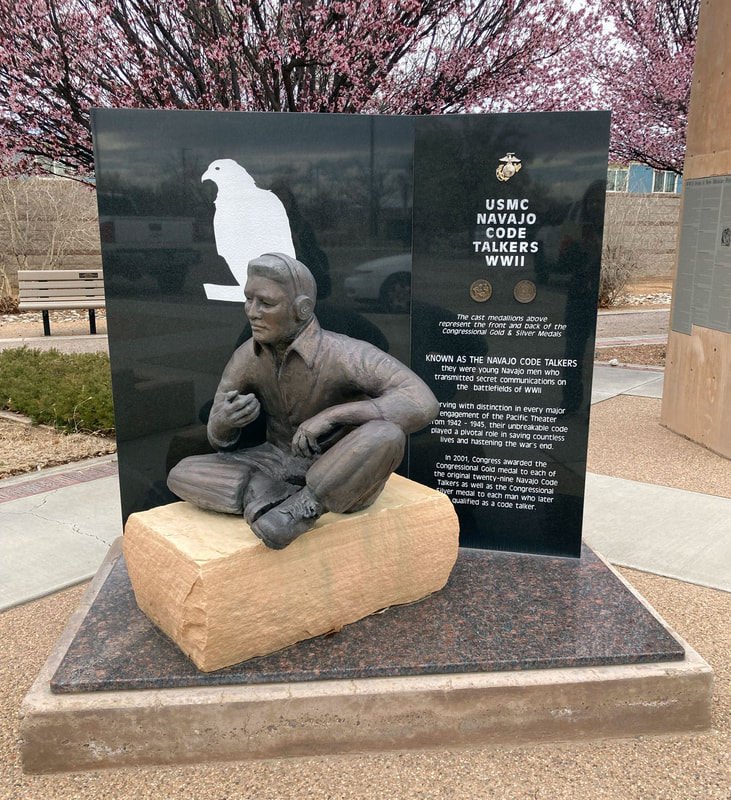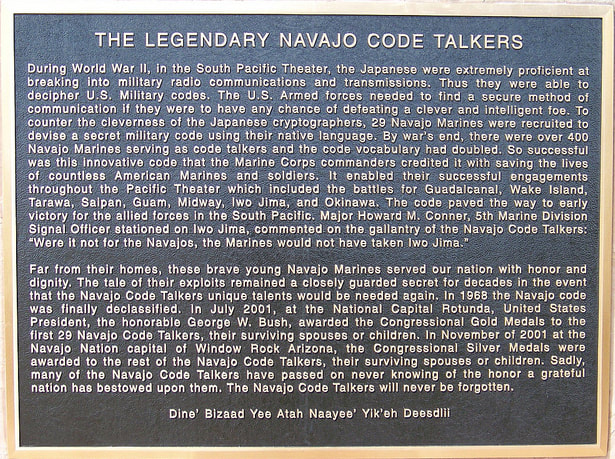Navajo Code Talkers MonumentCommunication is essential during any war and World War II was no different. From battalion to battalion or ship to ship – everyone must stay in contact to know when and where to attack or when to fall back. If the enemy were to hear these tactical conversations, not only would the element of surprise be lost, but the enemy could also reposition and get the upper hand. Codes (encryptions) were essential to protect these conversations.
Unfortunately, though codes were often used, they were also frequently broken. In 1942, a man named Philip Johnston thought of a code he thought unbreakable by the enemy. A code based on the Navajo language. The initial code consisted of translations for 211 English words most frequently used in military conversations. Included in the list were terms for officers, terms for airplanes, terms for months, and an extensive general vocabulary. Also included were Navajo equivalents for the English alphabet so that the code talkers could spell out names or specific places. On the battlefield, the code was never written down, it was always spoken. In training, they had been repeatedly drilled with all 411 terms. The Navajo code talkers had to be able to send and receive the code as fast as possible. There was no time for hesitation. Trained and now fluent in the code, the Navajo code talkers were ready for battle. The Navajo Code Talkers played a large role in the allied success in the Pacific. From 1942 until 1945, Navajo code talkers participated in numerous battles in the Pacific, including Guadalcanal, Iwo Jima, Peleliu, and Tarawa. They not only worked in communications but also as regular soldiers, facing the same horrors of war as other soldiers. Huddled over their radio sets in bobbing assault barges, in foxholes on the beach, in slit trenches, deep in the jungle, the Navajo Marines transmitted and received messages, orders, vital information. The Japanese ground their teeth and committed hari-kari.* The Navajo code talkers played a large role in the Allied success in the Pacific. The Navajos had created a code the enemy was unable to decipher. Bibliography Bixler, Margaret T. Winds of Freedom: The Story of the Navajo Code Talkers of World War II. Darien, CT: Two Bytes Publishing Company, 1992. Kawano, Kenji. Warriors: Navajo Code Talkers. Flagstaff, AZ: Northland Publishing Company, 1990. Paul, Doris A. The Navajo Code Talkers. Pittsburgh: Dorrance Publishing Co., 1973. *Excerpt from the September 18, 1945 issues of the San Diego Union as quoted in Doris A. Paul, The Navajo Code Talkers (Pittsburgh: Dorrance Publishing Co., 1973) 99. |
1. Bell Tower
2. Visitor / Event Center 3. Courtyard 4. Colonial War Kiosk 5. Territorial War Kiosk 6. World War I Kiosk 7. Buffalo Soldier Monument 8. Pearl Harbor Survivors Monument 9. World War II Kiosk & Monument 10. 8th Air Force Monument 11. Merchant Marines Monument 12. U.S. Submarine Veterans Monument 13. Welcome Home Memorial 14. U.S. Navy Veterans Monument 15. Korean War Monument & Kiosk 16. Vietnam War Monument & Kiosk 17. Expeditionary Missions Kiosk 18. Gulf War Kiosk 19. War On Terror Kiosk 20. The Call 21. The Preparation 22. The Battle 23. The Homecoming 24. The Conversation 25. The Word From Home 26. The Fallen Friend 27. Parade Ground 28. Amphitheater 29. Paratrooper Monument 30. Combat Infantry Badge Monument 31. Boulevard Of Flags & Blue Star Memorial 32. American Ex-Prisoner Of War Monument 33. Medal Of Honor Plaza 34. Purple Heart Monument 35. Holes In Our Hearts 36. American Veterans For Equal Rights 37. Tuskegee Airmen Monument 38. Gold Star Mothers Monument 39. Navajo Code Talkers Monument 40. Combined Action Program Monument |
- HOME
-
VISIT
-
MEMORIAL PARK
>
- THE MEMORIAL >
- KIOSKS >
- MEMORIALS >
-
MONUMENTS
>
- American Veterans For Equal Rights
- Buffalo Soldier Monument
- Combined Action Program Monument
- Combat Infantry Badge Monument
- 8th Air Force Monument
- Gold Star Mothers Monument
- Korean War Monument & Kiosk
- Merchant Marines Monument
- Navajo Code Talkers Monument
- Paratrooper Monument
- Pearl Harbor Survivors Monument
- Purple Heart Monument
- Tuskegee Airmen Monument
- U.S. Submarine Veterans Monument
- Vietnam War Monument & Kiosk
- VENUES >
- MUSEUM >
- VISITOR'S CENTER
- FOUNDATION OFFICE & LIBRARY
-
MEMORIAL PARK
>
- MEMORIAL GIFTS
- FACILITY RENTAL
- EVENTS CALENDAR
-
CONTACT
© 2023 New Mexico Veterans Memorial. Some photos courtesy of Paul Hyso. Website design by Amy Allen Designs
Privacy Policy
Privacy Policy
|
|
- HOME
-
VISIT
-
MEMORIAL PARK
>
- THE MEMORIAL >
- KIOSKS >
- MEMORIALS >
-
MONUMENTS
>
- American Veterans For Equal Rights
- Buffalo Soldier Monument
- Combined Action Program Monument
- Combat Infantry Badge Monument
- 8th Air Force Monument
- Gold Star Mothers Monument
- Korean War Monument & Kiosk
- Merchant Marines Monument
- Navajo Code Talkers Monument
- Paratrooper Monument
- Pearl Harbor Survivors Monument
- Purple Heart Monument
- Tuskegee Airmen Monument
- U.S. Submarine Veterans Monument
- Vietnam War Monument & Kiosk
- VENUES >
- MUSEUM >
- VISITOR'S CENTER
- FOUNDATION OFFICE & LIBRARY
-
MEMORIAL PARK
>
- MEMORIAL GIFTS
- FACILITY RENTAL
- EVENTS CALENDAR
-
CONTACT


